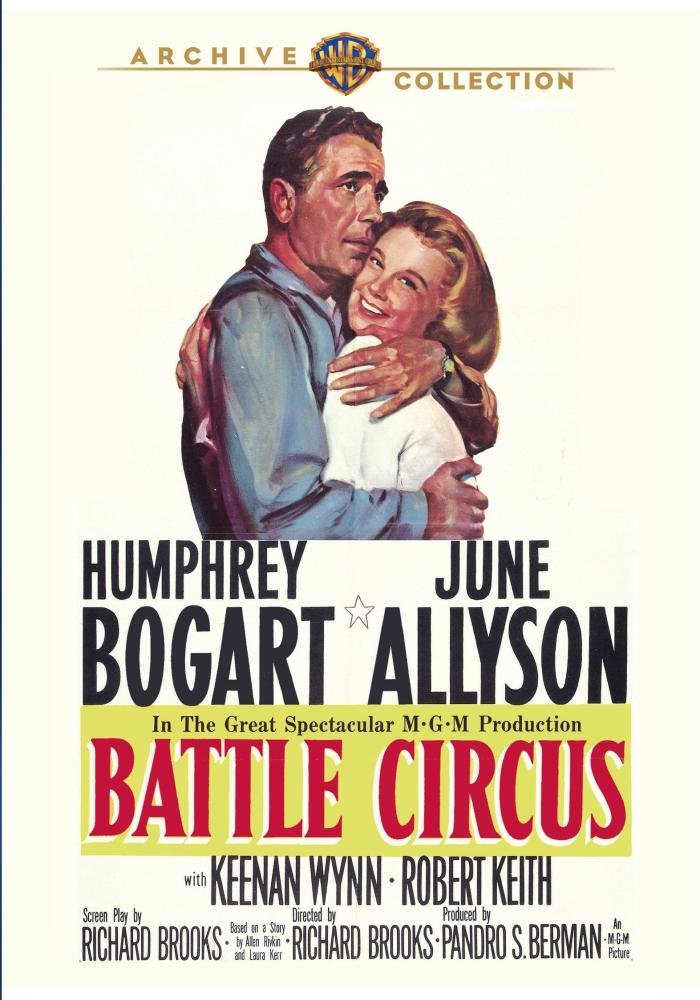
Written by Brandie Ashe
The description for 1953’s Battle Circus, now available on made-to-order DVD through the Warner Archive, labels the film as a sort of spiritual predecessor of the popular 1970s/80s television show M*A*S*H (as well as the 1970 theatrical film that inspired it). In many ways, this is an apt comparison—both take place in medical units (Mobile Army Surgical Hospitals) during the Korean War, both inject a healthy dose of levity to offset the darkness of the setting, and neither the film nor the TV show relent from occasionally depicting the horrors associated with battlefield medicine. And it does not end there; according to the TCM article on this film, in another interesting connection between the two, Battle Circus was originally titled MASH 66, but director Richard Brooks and the studio heads at MGM insisted upon changing it for, lacking faith in the cognitive abilities of the audience, Brooks and co. believed that people would think the film was about potatoes. The eventual title Battle Circus was chosen to refer to the efficient way in which the MASH units are able to strike their tents and move on to the next stage of battle, much like a traveling circus.
The central conceit of Battle Circus is the budding romance between Major Jed Webbe (Humphrey Bogart), a gruff, booze-swilling Army surgeon, and Lieutenant Ruth McGara (June Allyson), the young, idealistic nurse who eventually falls for him. The resulting contrast between the romantic plot and the wartime action makes for an awkward result. Part of the problem is that the developing romance seems out of place in the film, as if it has been shoehorned in so as to appeal to a female audience. But this would be less egregious were there any semblance of chemistry between Bogart and Allyson; as such, Webbe’s attraction to McGara is wholly inexplicable in the context of the film.
I would venture to say that Allyson is the weakest link in the movie, period. McGara is a strange character, fluctuating between worldliness (easily able to fend off Webbe’s amorous advances) and stupidity/innocence (what kind of Army nurse doesn’t know to take cover when shots are fired?), and in playing her, Allyson employs a kind of wide-eyed schtick that quickly grows tiresome. In comparison, Bogart makes Allyson look like the featured player at amateur hour; though he is, admittedly, not altogether believable as a gifted surgeon (just look at his relatively meaty hands), the mix of gravitas and twinkle that he brings to his role is appealing.
The strongest, most exciting element of Battle Circus is undoubtedly the war scenes, some of which reportedly feature authentic footage from the war front in Korea. There is no shortage of gritty, realistic moments in the movie: bodies strewn on the ground; men pinned down under enemy fire; the evacuation of casualties from live battle; exhaustive, hours-long surgical procedures. The understated pageantry of lowering and raising the medical tents at each new encampment is also intriguing to watch. The film only seems to find its footing and rhythm when concentrating on the business at hand instead of the forced romantic pairing of its leads.
Warner Archive advertises Battle Circus as “newly remastered,” and it is, in fact, a nice, crisp transfer. As with most “made on demand” discs, extras are sorely lacking; the only special feature included on this disc is the theatrical trailer for the film. I will admit I found myself sorely missing the option for subtitles or captioning in certain scenes, as some elements of dialogue are lost to the overwhelming sound effects of gunfire and helicopter rotors.
Despite the sometimes strange juxtaposition of romance and war, Battle Circus is a pretty entertaining film, if only for its realistic glimpse of the dangers of the Korean War. While Bogart and Allyson admittedly do not set the screen on fire (far from it), there is nonetheless an effective sense of urgency to the battlefield and surgical scenes that keeps the viewer invested in the story to the end.